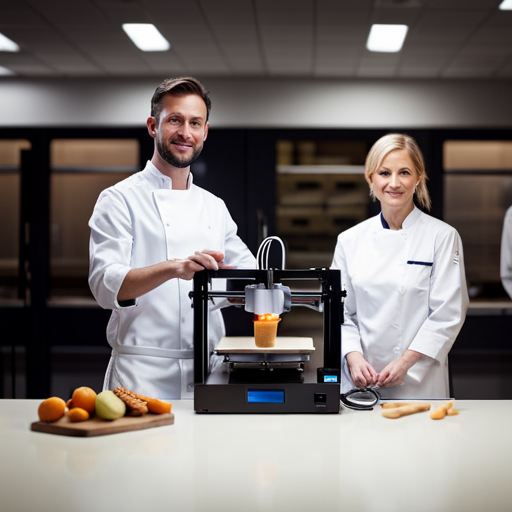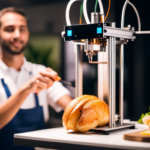Step into a world where culinary creativity meets cutting-edge technology. Collaborations and partnerships in food 3D printing are paving the way for groundbreaking innovations. Chefs are playing a crucial role in driving innovation, while technology companies are joining forces with culinary experts. This article explores the dynamic landscape of collaborative efforts that are shaping the future of food production. Join us as we delve into the exciting world of 3D printing in the food industry and uncover the latest trends and innovations.
The Role of Chefs in Innovation
The chefs’ role in innovation within food 3D printing is pivotal for driving culinary creativity and technological advancement. As the technology of 3D printing in the culinary world continues to evolve, chefs play a crucial role in pushing the boundaries of what is possible.
Their expertise in flavor profiles, textures, and presentation is instrumental in harnessing the full potential of 3D food printing. Chefs are at the forefront of experimenting with novel ingredients and designing intricate, customized shapes that were previously unattainable through traditional cooking methods.
Their deep understanding of food science and gastronomy enables them to explore new possibilities, leading to the creation of visually stunning and delicious dishes. Moreover, the role of chefs in embracing 3D food printing fosters a culture of innovation within the culinary industry, inspiring others to think outside the box and explore unconventional avenues for food creation.
This collaboration between technology and culinary artistry not only expands the horizons of culinary creativity but also drives the advancement of 3D printing technology in the food sector.
Technology Companies and Culinary Collaboration
In the realm of food 3D printing, technology companies and culinary experts are increasingly forging collaborative partnerships to drive innovation and advance the capabilities of this cutting-edge culinary technology. This collaboration brings together the expertise of technology companies in 3D printing with the culinary artistry of chefs, resulting in remarkable advancements in the way food is prepared and presented.
-
Integration of 3D Printing Technology: Technology companies are working closely with culinary professionals to integrate 3D printing technology into kitchen operations, allowing for the creation of intricate and personalized culinary designs that were previously unattainable through traditional methods.
-
Development of Specialized 3D Food Printers: Collaborations between technology companies and culinary experts have led to the development of specialized 3D food printers tailored to the unique requirements of professional kitchens, enabling chefs to explore new dimensions of creativity in their culinary creations.
-
Exploration of Innovative Ingredients: Through collaborative efforts, technology companies and culinary experts are exploring the use of innovative ingredients that can be utilized in 3D food printing, expanding the possibilities for culinary artistry and pushing the boundaries of gastronomic experiences.
3D Printing in Food Industry
The integration of 3D printing technology in the food industry has led to notable culinary innovations and the exploration of sustainable food production methods. This advancement has sparked creativity in the creation of intricate and customizable food designs, offering new opportunities for chefs and food companies to push the boundaries of culinary artistry.
Moreover, the potential for efficient and sustainable food production through 3D printing presents a promising solution to address the growing demand for environmentally friendly practices in the food industry.
Culinary Innovation With 3D Printing
Numerous culinary establishments are exploring the potential of 3D printing in the food industry to revolutionize their culinary innovation. This innovative technology allows chefs to create intricate designs and unique food presentations that were previously unattainable.
Some of the key aspects of culinary innovation with 3D printing include:
-
Customized Recipes: 3D food printing enables chefs to customize recipes according to individual preferences and dietary restrictions, providing a personalized dining experience for customers.
-
Printing Techniques: Chefs are experimenting with various printing techniques to create visually stunning and structurally complex dishes, pushing the boundaries of traditional culinary arts.
-
Ingredient Manipulation: 3D printing allows for precise control over ingredient placement, opening up new possibilities for texture, flavor combinations, and overall dining experiences.
Sustainable Food Production
Advancing sustainable food production in the food industry through 3D printing involves optimizing ingredient utilization and minimizing waste. This contributes to environmental conservation and resource efficiency. Sustainable agriculture practices and food waste reduction are crucial components of this approach.
3D printing allows for precise control over ingredient quantities, reducing excess and ensuring efficient use. By utilizing sustainable agricultural inputs and minimizing food waste, 3D printing technology supports environmentally friendly practices. This not only aligns with the global push for sustainable development but also addresses the food industry’s responsibility to minimize its environmental impact.
Furthermore, the reduction in waste through 3D printing aligns with the broader goal of sustainable resource management. These advancements in sustainable food production demonstrate the potential for positive environmental impact within the food industry.
This sets the stage for the subsequent discussion on educational institutions and industry partnerships, which play a pivotal role in driving these initiatives forward.
Educational Institutions and Industry Partnerships
Educational institutions have been increasingly forging partnerships with industry leaders to advance research and development in food 3D printing technology. These collaborations have proven to be instrumental in driving innovation and pushing the boundaries of what is possible in the realm of 3D printed food.
Some key aspects of these partnerships include:
-
Resource Sharing: Educational institutions and industry partners often pool their resources, including expertise, equipment, and funding, to support joint research projects and initiatives in food 3D printing.
-
Curriculum Development: Collaborations between educational institutions and industry leaders have led to the integration of food 3D printing technology into academic curriculums, ensuring that students are equipped with the necessary skills and knowledge to thrive in this emerging field.
-
Real-world Application: By partnering with industry, educational institutions can gain access to real-world industry insights and challenges, allowing for the development of research that is not only cutting-edge but also directly relevant to the needs of the food 3D printing industry.
Government Initiatives and Industry Collaboration
Government initiatives’ collaboration with industry partners is crucial for driving the advancement of food 3D printing technology.
In recent years, there has been a growing recognition of the potential of 3D printing in the food industry, prompting governments to provide support for research and development in this field.
Government support can take various forms, including funding for 3D printing research, the establishment of regulatory frameworks, and incentives for industry collaboration.
By partnering with industry players, governments can ensure that the technology developed aligns with industry needs and standards, thereby fostering industry development.
This collaboration also facilitates knowledge transfer and the sharing of best practices, which are essential for accelerating the growth of food 3D printing.
Furthermore, industry collaboration allows for the pooling of resources and expertise, leading to more efficient problem-solving and innovation.
Ultimately, a strong partnership between the government and industry is essential for creating an environment conducive to the advancement of food 3D printing technology, ensuring its integration into the mainstream food industry.
Culinary Creativity Meets Engineering Expertise
The fusion of flavors and designs, coupled with the innovation in food, has led to a fascinating intersection where culinary creativity meets engineering expertise.
As chefs and food scientists collaborate with engineers and technology experts, the possibilities for creating unique and intricate food designs are expanding.
This partnership not only challenges traditional culinary boundaries but also opens up new avenues for experimentation and creativity within the realm of 3D food printing.
Fusion of Flavors and Designs
How can culinary creativity be seamlessly integrated with engineering expertise in the fusion of flavors and designs in food 3D printing?
The fusion of flavors and designs in food 3D printing requires a delicate balance of artistic flair and technical precision. Here are three key aspects to consider:
-
Ingredient Compatibility: Ensuring that the flavors of different ingredients complement each other when fused together in a 3D printed dish.
-
Aesthetic Appeal: Creating visually stunning designs that not only look appealing but also enhance the overall dining experience.
-
Printing Techniques: Utilizing advanced 3D printing techniques to effectively combine different flavors and textures while maintaining the structural integrity of the food.
Successfully merging flavor fusion and artistic designs demands a deep understanding of both culinary arts and engineering principles.
Innovation in Food
Culinary innovation in food 3D printing necessitates a harmonious blend of creative gastronomy and technical acumen. Culinary artistry is at the core of this innovation, where chefs and food technologists collaborate to push the boundaries of traditional food preparation.
Technological advancements have enabled the translation of intricate culinary designs into 3D-printed edible creations, allowing for unprecedented levels of precision and complexity in food presentation. Chefs are now able to experiment with textures, shapes, and structures that were previously unattainable through conventional methods.
Moreover, the marriage of culinary creativity with engineering expertise has paved the way for the development of novel ingredients and recipes specifically tailored for 3D printing, further expanding the possibilities within the realm of gastronomy.
This convergence of culinary artistry and technological advancements continues to drive the evolution of food 3D printing, opening new frontiers in culinary experiences.
Sustainable Food Production Collaborations
Sustainable food production collaborations are essential for advancing the capabilities and applications of 3D printing technology in the food industry. The following are key aspects of sustainable food production collaborations:
-
Sustainability Partnerships: Collaborations between 3D printing technology companies and sustainable food production initiatives are crucial for ensuring that the materials and processes used in 3D food printing align with sustainable practices. This involves sourcing eco-friendly ingredients and optimizing production methods to minimize waste and energy consumption.
-
Food Security Collaborations: Partnering with organizations focused on food security is vital for leveraging 3D printing technology to address global food scarcity. By working together, these collaborations can explore innovative ways to use 3D printing for creating nutrient-dense foods, especially in regions facing food shortages.
-
Research Consortiums: Collaborative efforts between academic institutions, research organizations, and industry stakeholders play a pivotal role in advancing sustainable food production through 3D printing. These partnerships drive research into novel ingredients, printing techniques, and food formulations that are environmentally friendly and contribute to sustainable food systems.
As sustainable food production collaborations continue to evolve, they are shaping the future of food 3D printing by integrating ecological responsibility with technological innovation. This progress sets the stage for examining future trends and innovations in food 3D printing.
Future Trends and Innovations in Food 3D Printing
Exploring advancements in 3D food printing technology is crucial for anticipating future trends and innovations in the food industry. One of the key future trends in food 3D printing is the increasing focus on consumer adoption. As technology advances and becomes more accessible, there is a growing interest in how 3D printed food can be integrated into everyday consumer lifestyles.
This trend is likely to drive further innovation in 3D food printing, with an emphasis on creating user-friendly devices and expanding the range of printable food materials. Additionally, regulatory challenges will play a significant role in shaping the future of food 3D printing.
As this technology evolves, regulatory bodies will need to establish guidelines and standards to ensure the safety and quality of 3D printed food products. Addressing regulatory challenges will be essential for fostering consumer trust and facilitating the widespread adoption of 3D food printing technology.
Frequently Asked Questions
What Are the Key Challenges Faced by Chefs in Implementing 3D Printing Technology in Their Culinary Creations?
Implementing 3D printing technology in culinary creations presents challenges for chefs in integrating technology, maintaining food quality, and ensuring regulatory compliance. They must navigate technical complexities and balance traditional culinary techniques with innovative technology.
How Do Technology Companies and Culinary Professionals Collaborate to Ensure That 3D Printing in Food Industry Meets High Quality and Safety Standards?
In the pursuit of culinary innovation, technology integration is vital for ensuring high quality and safety standards in 3D printing for the food industry. Collaboration between technology companies and culinary professionals facilitates this seamless fusion.
What Specific Educational Programs or Initiatives Are in Place to Train Future Professionals in the Field of 3D Printing in Food Industry?
Educational programs and training initiatives for future professionals in the 3D printing in food industry are essential to ensure industry standards. These programs focus on developing expertise in food technology, engineering, and culinary arts.
What Role Does Government Play in Promoting and Regulating Collaborations and Partnerships in Food 3D Printing?
How does the government influence collaborations and partnerships in food 3D printing? Government regulations ensure safety and quality standards, while industry promotion can foster innovation and investment. Balancing regulation and support is pivotal for sustainable growth.
How Do Collaborations Between Culinary Creativity and Engineering Expertise Contribute to the Development of Sustainable Food Production Methods Through 3D Printing?
Culinary innovation and engineering sustainability merge in collaborations to develop 3D printed food, revolutionizing sustainable production methods. This synergy fosters novel solutions, blending creative culinary concepts with advanced engineering techniques to address global food challenges.
Conclusion
In conclusion, collaborations and partnerships in food 3D printing have paved the way for culinary creativity to meet engineering expertise, leading to sustainable food production and future trends in the industry.
This fusion of culinary and technology has created a recipe for success, blending the art of cooking with the precision of engineering to serve up a delicious feast of innovation for the future.


